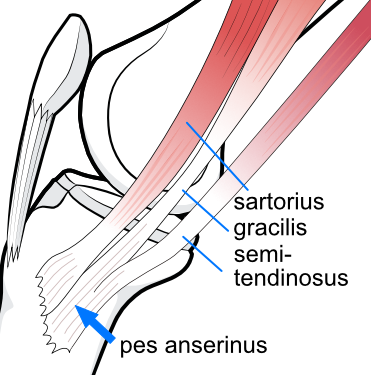
Going back to our analogy, think of this as more and more pinpricks in that rubber band, followed by a big build-up of glue around the area. Overtime, this scar tissue will build up and will start to interfere with the normal strength and flexibility of the muscles. If the overload at the iliotibial band continues (this is almost always associated with problems at the hip or foot, which will be discussed below) there will be ongoing micro-trauma and subsequent repair of this micro-trauma. This little pin-prick does not affect the rubber band much, but we still want to repair it so we put a little dab of glue over the area. For an analogy, think of a big rubber band with a pinprick in it. This new tissue, often referred to as scar tissue or soft tissue adhesions, is very sticky and acts to ‘glue’ the damaged tissues back together. The body does this by forming new tissue in and around the injured tissue, in this case, in and around the pes anserinus muscles or tendons. Although only small this damage still needs to be repaired. This damage is referred to as ‘micro-trauma. Unlike a traumatic injury which is caused abruptly following a trauma or accident, repetitive strain injuries (referred to as an RSI for short) are associated with very small amounts of tissue stress and damage that accumulates slowly over time.Īs the muscles are stressed and over-used it can lead to small scale damage. Pes Anserine Bursitis is an example of a repetitive strain injury. In later stages, pain may worsen and be present during activity.In the early stages, pain symptoms usually improve with warm-up or exercise.When the bursa is involved night pain may occur.Tenderness and/or swelling just below the medial knee.

Stiffness or tightness may be present in the groin, thigh, or hamstrings.Pain will often be aggravated by climbing upstairs.Gradual onset of pain at, or just below the anterior-medial aspect of the knee.Signs and Symptoms of Pes Anserine Bursitis Either of these situations will cause pain on the front/inside aspect of the knee. With excess stress or overuse, one or more of these muscles can become strained or overloaded, which will cause the muscle(s) to pull on their insertion point at the anterior-medial knee, or to compress a small bursa located underneath the tendon where it inserts onto the knee. Pes Anserinus is the anatomical term used to describe the common insertion point of a group of thigh muscles (sartorius, gracilis, semtendinosis) on the anterior-medial aspect of the knee.


 0 kommentar(er)
0 kommentar(er)
